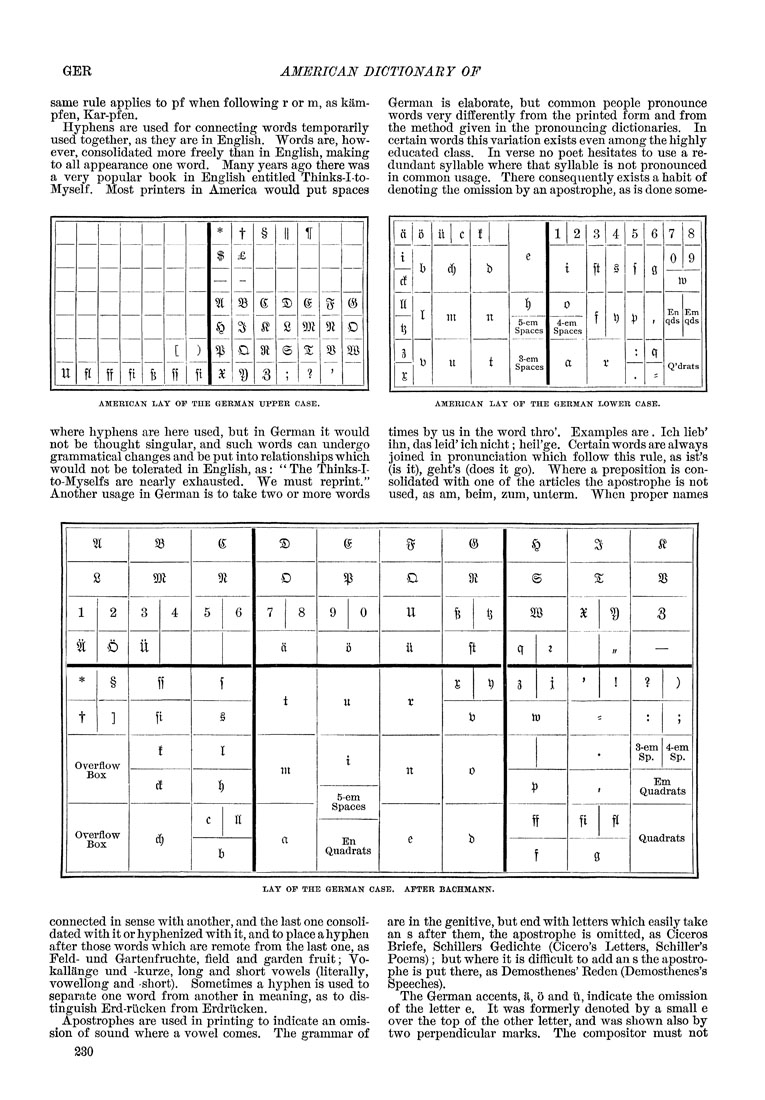GER
AMERICAN DICTIONARY OF
same rule applies to pf when following r or m, as kam-
pfen, Kar-pfen.
Hyphens are used for connecting words temporarily
used together, as they are in English. Words are, how¬
ever, consolidated more freely than in English, making
to all appearance one word. Many years ago there was
a very popular book in English entitled Thinks-I-to-
Myself. Most printers in America would put spaces
German is elaborate, but common people pronounce
words very differently from the printed form and from
the method given in the pronouncing dictionaries. In
certain words this variation exists even among the highly
educated class. In verse no poet hesitates to use a re¬
dundant syllable where that syllable is not pronounced
in common usage. There consequently exists a habit of
denoting the omission by an apostrophe, as is done some-
—
—
—
—
—
—
*
$
t
£
§
X
T
—
—
u
p
T
T
6
[
f!
)
^l
§
^
58
8
2)
2
e
(5
m
%
fi
ae
a
0
il
c
!
1
2
3
4
5
6
7 J8
i
d
b
d)
b
e
t
ft
§
f
9
0 9
U)
11
I
in
n
5-em
Spaces
3-em
Spaces
0
f
i)
P
1
En
qds
Em
qds
4-em
Spaces
3
-0
u
t
a
X
—
c\
Q'drats
AMERICAN LAY OF THE GERMAN UPPER CASE.
AMERICAN LAY OF THE GERMAN LOWER CASE.
where hyphens are here used, but in German it would
not be thought singular, and such words can undergo
grammatical changes and be put into relationships which
would not be tolerated in English, as: " The Thinks-I-
to-Myselfs are nearly exhausted. We must reprint."
Another usage in German is to take two or more words
times by us in the word thro'. Examples are . Ich lieb'
ihn, das leid' ich nicht; heil'ge. Certain words are always
joined in pronunciation which follow this rule, as ist's
(is it), geht's (does it go). Where a preposition is con¬
solidated with one of the articles the apostrophe is not
used, as am, beim, zum, unterm. When proper names
%
58
(5:
^
@
3
@
§
^
^
2
m
^
D
?
o
U
@
%
58
1
2
3
4
5
6
7
8
9
0
u
6
t3
m
ae
%
3
5t
6
ix
ci
0
il
ft
q
z
If
—
*
§
ff
f
1
I
^
a
i
1
I
?
)
u
X
t
]
fi
§
b
to
-'
J
\
Overflow
Box
!
I
nt
i
n
0
♦
3-em
Sp.
4-em
Sp.
d
5
p
»
Em
Quadrats
5-em
Spaces
c
U
ff
fi
ft
Overflow
e
V,
r\ A 4.
B(
)X
u
y
b
r
I
E
Quae
n
irats
c
f
0
LAY OF THE GERMAN CASE. AFTER BACHMANN.
connected in sense with another, and the last one consoli¬
dated with it or hyphenized with it, and to place a hyphen
after those words which are remote from the last one, as
Feld- und Gartenfruchte, field and garden fruit; Vo-
kallange und -kurze, long and short vowels (literally,
vowellong and short). Sometimes a hyphen is used to
separate one word from another in meaning, as to dis¬
tinguish Erd-rlicken from Erdrlicken.
Apostrophes are used in printing to indicate an omis¬
sion of sound where a vowel comes. The grammar of
230
are in the genitive, but end with letters which easily take
an s after them, the apostrophe is omitted, as Ciceros
Briefe, Schillers Gedichte (Cicero's Letters, Schiller's
Poems); but where it is difficult to add an s the apostro¬
phe is put there, as Demosthenes' Reden (Demosthenes's
Speeches).
The German accents, a, o and ii, indicate the omission
of the letter e. It was formerly denoted by a small e
over the top of the other letter, and was shown also by
two perpendicular marks. The compositor must not
|








